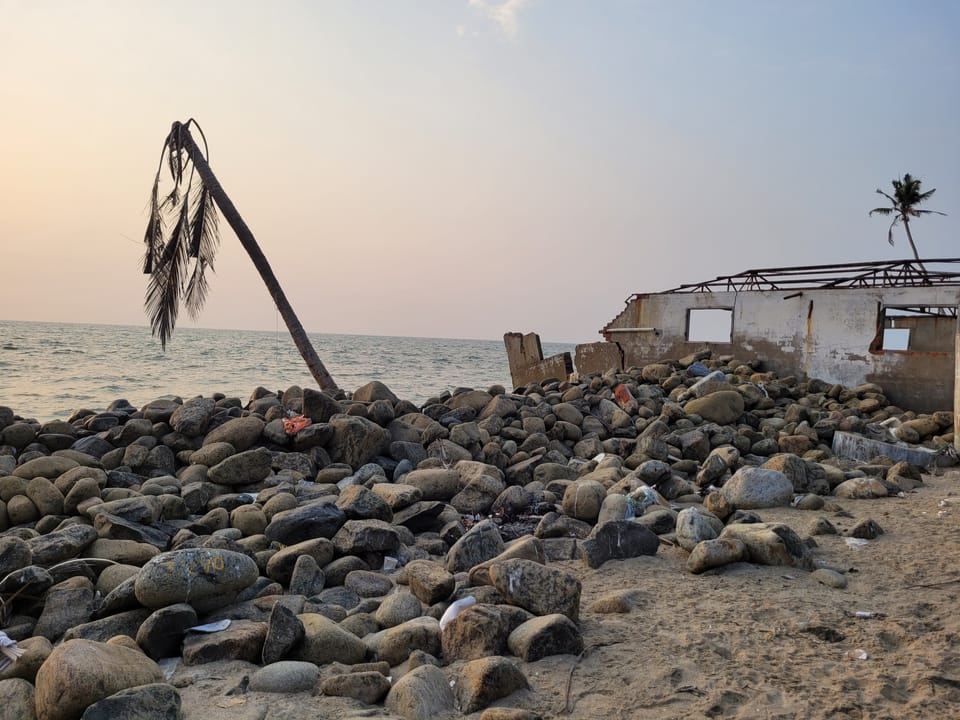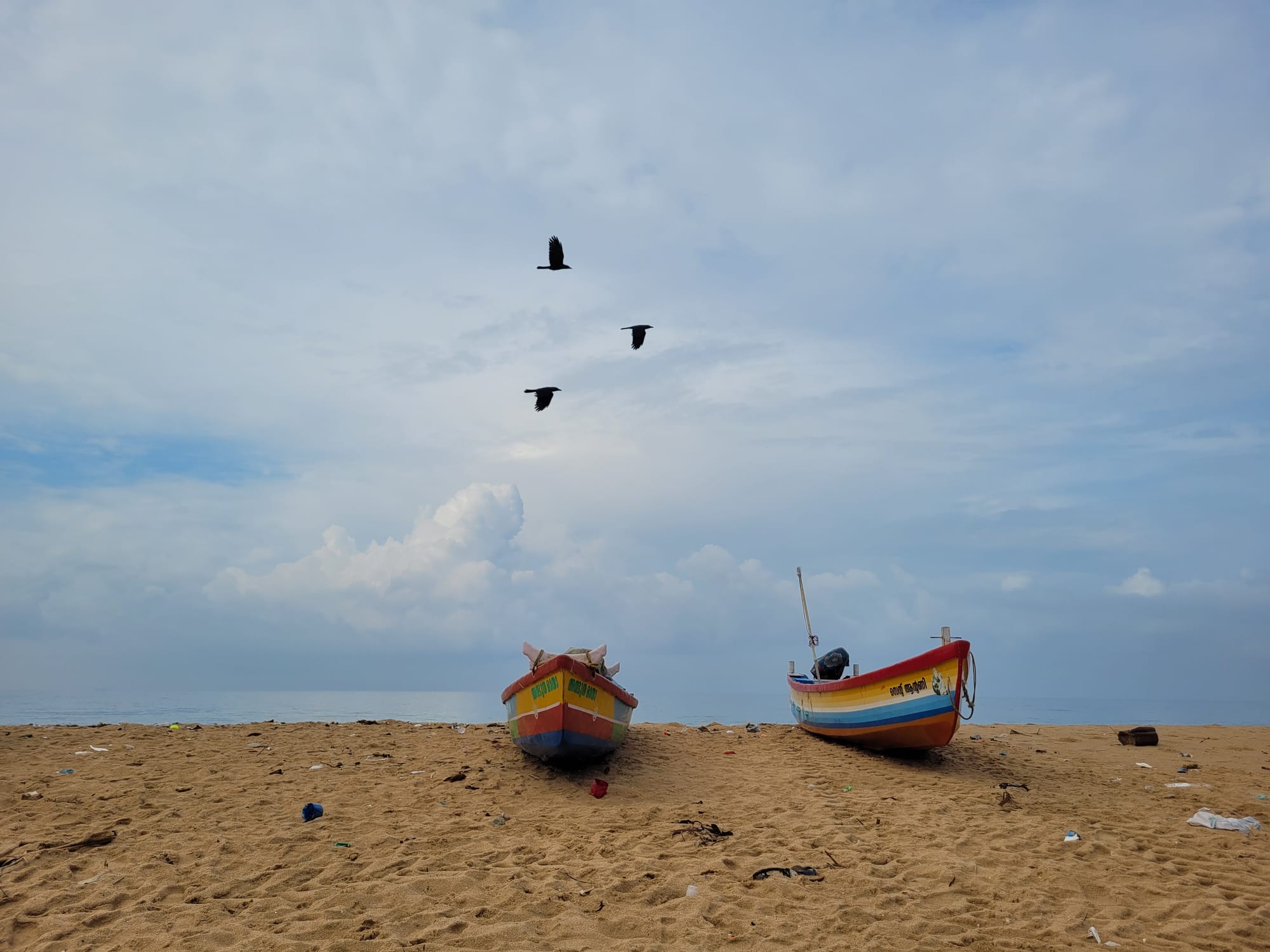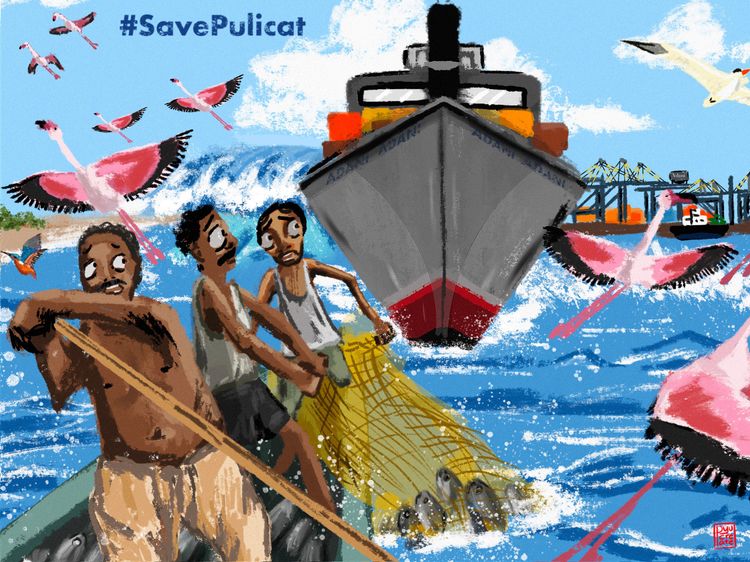#7 Climate Change & Infra Boom: A match made in hell

On 4th December, as parts of Tamil Nadu and Andhra Pradesh were getting pummeled by Cyclone Michaung, a severe cyclonic storm passing through the east coast of India, the waters of Ennore Creek, a backwater located in north Chennai, witnessed a plot twist of a different kind. Crude oil seeped into its waters, forming an ever-increasing, shape-shifting, sheet of oil on its surface. The crude oil belongs to Chennai Petroleum Corporation Limited, a refinery and subsidiary of Indian Oil Corporation Limited located in Ennore. During the cyclone, the waters of Buckingham Canal that connects to the backwaters increased, causing a reverse flow. Oil spilled from the refinery and mixed with these flood waters, making their way into the creek waters and getting trapped there. The oil and its odor went where the water went – oozing into the sand, forming a thick layer on the streets, boats, nets, floors and walls of people’s homes, suffocating the fish, and causing severe harm to the health and overall well-being of residents living in the vicinity. At least eight fishing villages have been affected by this oil spill.
Three weeks later, on 27th December, the same area witnessed ammonia gas leak from a pipeline connected to the storage tanks of Coromandel International Limited, a private fertilizer manufacturing company. The company produces four lakh tonnes of ammonium phosphate potash sulphate annually, and uses ammonia as one of the raw materials. It is brought into the state through ships that dock at the minor port of Ennore, and transferred through the pipeline which is cooled for 36 hours before the transfer in liquid form. Shortly after, people living in the vicinity started complaining of severe breathlessness, and irritation in the eyes and throat. So far, over fifty people have been hospitalized and shoals of dead fish are floating in the creek. The residents of the area, mostly fishers, have gone on an indefinite strike, demanding a permanent closure of the fertilizer manufacturing unit.
As Ennore attempts to recover from this mess, a question comes to mind. What if this cyclone waltzed through an Ennore that was devoid of this refinery and this fertilizer unit? What if the entire area of Ennore Creek, which was once a flourishing mangrove swamp, not only supporting a vital aquatic ecosystem, but also helping mitigate flooding in times of strong rainfall, high tides and cyclones, was NOT surrounded by thermal power plants, oil refineries, fertilizer manufacturing units and the ever-expanding commercial cargo ports? Would it have been as badly affected by the increasing frequency of climate-change induced cyclonic events?
As the frequency of these erratic climate events rises over time, global outfits with money and power, such as World Bank, Asian Development Bank are pumping money into the country’s coastline for climate adaptation and mitigation measures. Using phrases such as 'coastal resilience', they are funding projects to cover the coastline with seawalls and geotubes, constructing concrete embankments along water bodies, all with the logic to prevent the intrusion of flood waters onto the land. Considering the nature of damage caused by cyclones, is this really what we need to be focusing on? Hasn't science explained enough that constructions do not help mitigate floods? Isn't construction THE ACTUAL problem?
India's Infra goes boom boom boom
India, currently the fifth–largest economy in the world, aims to take the third spot by 2030. The top priority for the Indian government – a boost in infra development.
India aspires to become a US$5 trillion economy by 2028-29,. for which the expansion of roads, railways, ports, power plants and renewable energy infrastructure is critical.
In December 2022, India’s ministry of ports, shipping and waterways said it had a pipeline of 81 public-private partnerships to be awarded before March 2025. India received foreign investments worth more than US$6 billion in ports and sea transportation from April 2000 to March 2022, and seeks more.
In September this year, JSW Infrastructure, Jindal’s commercial port operator, entered the market and received bids worth $7.29 billion in its initial public offering (IPO). It rivals Adani Ports, currently India’s biggest port operator. While half of India’s port capacity is still run by the central government, Adani Ports controls 24 per cent of India’s port cargo handling and JSW Infrastructure accounts for 6 per cent.
Their projects are not only looking into expanding the current ports in the country, but also looking to construct ports from scratch, on coastal commons land that, in some parts, is elusive because of its erosive nature, and in other parts, holds vital ecosystems that act as natural barriers to climate catastrophes.
One of Adani Ports' biggest project to date is the deep-water transshipment port at Vizhinjam harbor in south Kerala. The project has been under construction since 2015 and is now touted to be operational by 2024. It boasts of having the capacity to dock Ever Alot, one of the largest container ships in the world. Ships that are extremely large need a deep seabed to be able to park. The average depth needed for a large vessel to dock is 15 to 18meters. Vizhinjam harbour has a natural depth of 18metres, and therefore requires minimal to no dredging of the seabed. The media is going wild over this factoid, because dredging itself is an exceedingly costly affair.
What falls through the cracks
What we often miss in such siloed-stories and conversations is that this port is not being built on some new land. It is built on land on land that used to be a commons, that belonged to the people, where they have lived, and used the space to park their boats, repair their nets, sort and sell their fish. It has been a source of livelihood for them. What falls through the cracks is that Vizhinjam was once a harbour of procreation. Its waters were so rich with fish because of a unique reef system that fishers from neighboring villages would find and sell fish from its waters. It supported the economy of at least twenty villages. Today, thanks to constructions, the reefs that housed the fish are destroyed. The fish is gone. What exists today for the people of Vizhinjam is fish famine. It isn't the rise in sea-surface temperature that caused this. It is the construction of this port. The 'boom' and the promise of a greater good for the country's economy has only caused destruction, displacement and disillusionment for her fishers.

Our narratives around climate change impacts for the coastline need to change, and address the impacts of infra projects more starkly. The two conversations can no longer happen in separate silos. With each new cyclone or infra project, fishers are being pushed further and further into a corner.
As we move into the new year, it is imperative to understand that conversations of development and destruction are entwined with each other. A resident of Ennore, while talking about the ammonia gas leak tragedy, says it clearly "...that Chennai is developing by tugging at the working class, the economy and biological resources of northern Chennai."
One man’s vision for a better world is coming from the destruction of another’s. This must stop.
Further Readings
Indian ports operator JSW Infrastructure shares jump 30% in debut: https://www.ft.com/content/f597ea8d-924f-45b7-b963-c826efb641f3
JSW Infrastructure to develop Keni port in Karnataka for ₹4,119 crore: https://www.thehindu.com/news/national/karnataka/jsw-infrastructure-to-develop-keni-port-in-karnataka-for-4119-crore/article67540899.ece
Building boom in India: https://www.straitstimes.com/multimedia/graphics/2023/08/india-infrastructure-big-plans/index.html
Foreign Direct Investment (FDI) in India: Inflows in 2023 and last 10 years: https://www.forbesindia.com/article/explainers/fdi-in-india-inflows/89609/1
‘What do we do now?’: At Ennore Creek oil spill site, fishermen stare at a bleak future: https://indianexpress.com/article/cities/chennai/ennore-creek-oil-spill-chennai-tamil-nadu-fishermen-9073977/
Fish famine, livelihood loss because of upcoming Vizhinjam port, say fishers of south Kerala: https://india.mongabay.com/2022/05/fish-famine-livelihood-loss-because-of-upcoming-vizhinjam-port-say-fishers-of-south-kerala/


